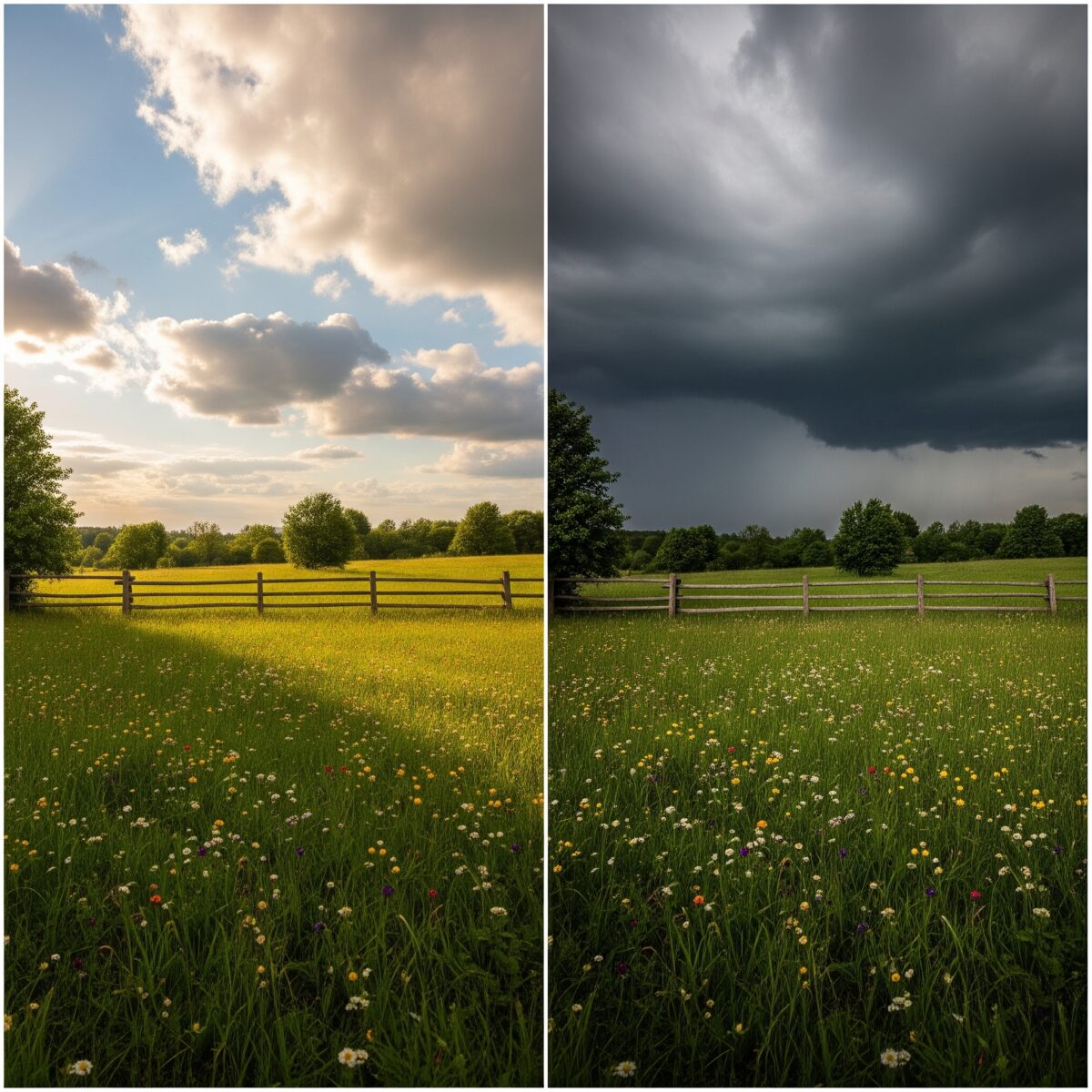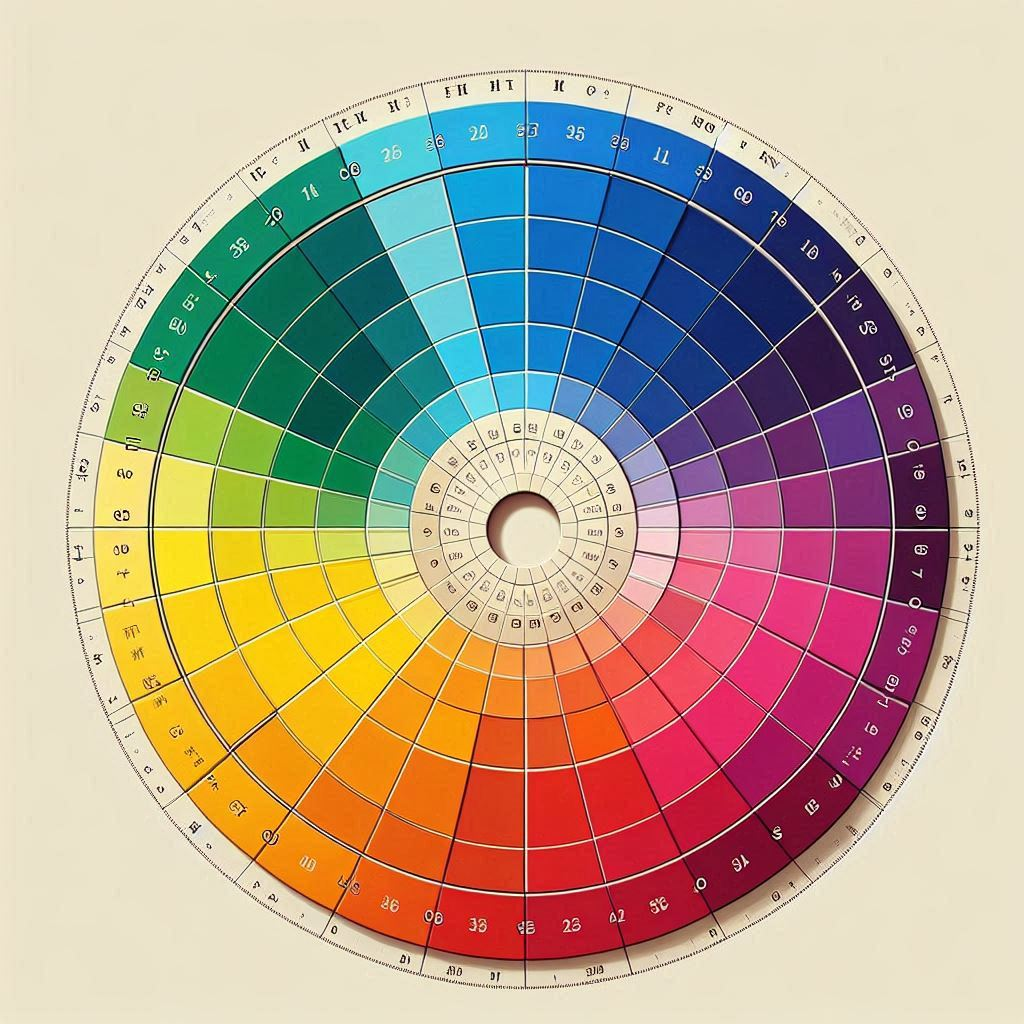Have you ever wondered why some paintings seem to jump off the canvas while others look flat and lifeless? The secret lies in understanding how to use shadow in art effectively. Shadows aren’t just dark areas – they’re powerful tools that can transform your artwork from amateur to professional-looking. When you master light and shadow painting techniques, you’ll create paintings with incredible depth, drama, and realism that captivate viewers and bring your artistic vision to life.
Key Points Summary:
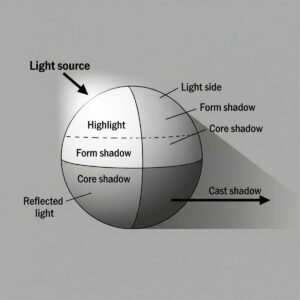
- Shadows create depth, form, and three-dimensional effects in paintings
- Chiaroscuro technique uses dramatic light-dark contrasts for powerful visual impact
- Understanding different shadow types (cast, core, reflected) improves realistic painting
- Value studies help artists practice tonal relationships before creating finished works
- Proper shadow techniques work across all mediums – oils, acrylics, watercolors, and digital art
Understanding the Magic of Shadows in Painting
Think of shadows as the unsung heroes of the art world. While bright colors and bold brushstrokes often get attention, shadows quietly do the heavy lifting. They tell us where objects sit in space, how light moves across surfaces, and even what time of day it might be in a painting.
Shadow in art serves three main purposes: creating form, establishing depth, and setting mood. When light hits a round apple, for example, the shadow side tells our brain it’s three-dimensional, not just a flat circle. This is why understanding color theory in art becomes so important – shadows aren’t just black or gray, they contain subtle color variations that make paintings come alive.
The Science Behind Light and Shadow Effects
Before diving into techniques, let’s understand what happens when light meets objects. Every shadow has a story to tell about the light source creating it.
| Shadow Type | Description | Purpose in Art |
|---|---|---|
| Core Shadow | The darkest part directly opposite the light | Shows the form’s turning point |
| Cast Shadow | Shadow thrown onto other surfaces | Anchors objects to their environment |
| Reflected Light | Subtle light bouncing back into shadow areas | Prevents shadows from going completely black |
| Highlight | The brightest point where light hits directly | Creates the illusion of three-dimensional form |
Understanding these shadow shapes in painting helps you observe real life more carefully. Next time you’re near a window, notice how these different shadow types work together on everyday objects.
Mastering the Chiaroscuro Technique

Chiaroscuro – this fancy Italian word simply means “light-dark” – is one of the most powerful shadow painting techniques in art history. Artists like Leonardo da Vinci and Caravaggio used dramatic lighting to create paintings that seem to glow from within.
“Chiaroscuro is not just a technique; it’s a way of seeing the world in terms of light and shadow relationships.”
The beauty of chiaroscuro lies in its boldness. Instead of subtle gradations, you create strong contrasts between light and dark areas. This technique works especially well for:
- Portrait painting (dramatic face lighting)
- Still life compositions (highlighting key objects)
- Religious or historical scenes (creating emotional impact)
To practice chiaroscuro in your own work, start with simple subjects like fruits or everyday objects. Use a single, strong light source (like a desk lamp) and really push the contrast between your lightest lights and darkest darks.
Creating Depth Through Value Study Art
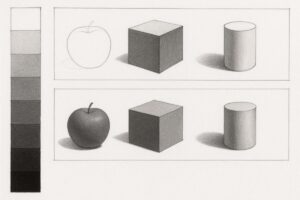
Before tackling complex paintings, smart artists create value studies (see our article on value studies) – simple drawings that focus only on light and shadow relationships. Think of value studies as your painting’s blueprint.
A value study strips away color and detail, showing only the grayscale relationships in your composition. This helps you:
- Plan where your eye should travel through the painting
- Identify potential problem areas before adding color
- Understand the overall light pattern
- Practice tonal values without getting distracted by details
Professional artists often create multiple value studies for a single painting. It might seem like extra work, but this preparation saves hours of frustration later and dramatically improves your final results.
Shadow Techniques Across Different Mediums
Every painting medium handles shadows differently, and understanding these differences helps you choose the right approach for your artistic goals.
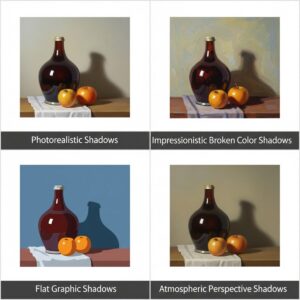
Oil Painting Shadow Mastery
Oil paints excel at creating smooth shadow gradations because they stay workable for hours. This allows you to blend edges seamlessly and build up subtle variations within shadow areas. The 10 must-know techniques for beginner oil painters includes several shadow-specific approaches that transform ordinary paintings into masterpieces.
Watercolor Shadow Challenges
Watercolor shadows require more planning since you can’t easily correct mistakes. The key is understanding transparent color mixing and leaving white paper for your brightest highlights. Wet-in-wet techniques create beautiful soft shadow edges, while wet-on-dry applications give crisp, defined shadows.
Acrylic Shadow Solutions
Acrylics dry quickly, making them perfect for layered shadow techniques. You can build up shadows gradually, from light to dark, without waiting days for each layer to dry. The mastering acrylic painting guide covers specific shadow mixing techniques that work beautifully with this versatile medium.
Common Shadow Mistakes and How to Fix Them
Even experienced artists struggle with shadows sometimes. Here are the most frequent problems and their solutions:
Mistake #1: Making all shadows the same darkness Solution: Observe how shadows have different values depending on their distance from the light source and surrounding reflected light.
Mistake #2: Using pure black for shadows Solution: Mix your darks with complementary colors for richer, more natural-looking shadows.
Mistake #3: Ignoring reflected light Solution: Look for subtle light bouncing back into shadow areas – it prevents flat, lifeless shadows.
Mistake #4: Inconsistent light sources Solution: Establish your light direction early and stick with it throughout the entire painting.
These insights align with common challenges covered in common painting mistakes beginners make, where shadow-related errors rank among the top issues for developing artists.
Shadow Tool
Welcome to this interactive 3D Light and Shadow Viewer! This tool allows you to explore how light interacts with different objects in a virtual environment.
You can select from various 3D shapes like a sphere, cube, or knot. The most exciting feature is the ability to control the directional light source. Use the sliders on the left to move the light along the X, Y, and Z axes, and observe how the shadows dynamically change on the object and the ground plane. You can also rotate, zoom, and pan the view using your mouse to get different perspectives. Experiment to understand the fascinating interplay of light and shadow!
Controls:
- Rotate: Left-click and drag.
- Zoom: Mouse wheel scroll.
- Pan: Right-click and drag.
The Emotional Power of Dramatic Lighting
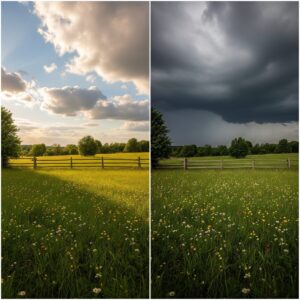
Shadows don’t just create form – they create feeling. The same subject can evoke completely different emotions depending on how you handle the lighting.
Soft, diffused shadows suggest calm, peaceful moods. Think of a gentle morning light filtering through curtains. Sharp, dramatic shadows create tension and excitement, like the harsh lighting in a thriller movie.
How to create mood with color choices explores how shadow colors particularly influence emotional responses in viewers. Warm shadows (containing reds and oranges) feel inviting, while cool shadows (with blues and purples) can seem mysterious or melancholy.
Composition and Shadow Placement
Strategic shadow placement guides viewers through your painting like invisible arrows. Essential elements of composition explains how shadows function as crucial compositional tools.
Consider shadows as shapes in their own right. Strong shadow shapes can:
- Balance bright areas in your composition
- Create interesting negative spaces
- Connect separate elements into unified groups
- Lead the eye toward your focal point
Professional artists often design their shadow patterns before worrying about individual objects. This “shadow design” approach ensures the overall composition works before adding details.
Advanced Shadow Techniques: Beyond the Basics
Once you’re comfortable with basic shadow principles, explore these advanced approaches:
Ambient Occlusion: The subtle darkening that occurs where surfaces meet. This technique, borrowed from digital art, adds incredible realism to traditional paintings.
Subsurface Scattering: How light partially penetrates translucent materials like skin or leaves before bouncing back. Understanding this creates more convincing organic subjects.
Multiple Light Sources: While beginners should stick to single light sources, advanced artists can juggle multiple lights for complex, sophisticated effects.
Masters of Shadow
| Artist | Nationality | Era | Notable Works / Techniques |
|---|---|---|---|
| Rembrandt van Rijn | Dutch | Baroque (17th c.) | The Night Watch, Self-Portraits; Master of chiaroscuro and tenebrism |
| Caravaggio | Italian | Baroque (16th-17th c.) | Saint John the Baptist, The Calling of Saint Matthew; Pioneer of tenebrism |
| Leonardo da Vinci | Italian | Renaissance (15th-16th c.) | The Virgin of the Rocks, Mona Lisa; Developed chiaroscuro technique |
| Georges de La Tour | French | Baroque (17th c.) | La Madeleine à la flamme filante; Candlelit scenes, dramatic shadows |
| Artemisia Gentileschi | Italian | Baroque (17th c.) | Judith Slaying Holofernes; Bold chiaroscuro, emotional intensity |
| Gerrit Dou | Dutch | Baroque (17th c.) | Night scenes, candlelight effects; Student of Rembrandt |
| Raphael | Italian | High Renaissance (16th c.) | Use of single light source, volumetric modeling |
| Franz von Stuck | German | Symbolist (19th-20th c.) | Expressive use of shadow in mythological scenes |
| Nikolai Ge | Russian | Realism (19th c.) | Self-Portrait (1892); Dramatic shadow in portraiture |
| Johannes Vermeer | Dutch | Baroque (17th c.) | Subtle shadow and light in interior scenes |
Tools and Resources for Shadow Mastery
Beyond traditional observation and practice, modern artists have access to helpful tools:
- Value viewers: Simple red or green filters that help you see value relationships more clearly
- Digital apps: Photography apps that convert images to grayscale for value studies
- Reference photos: High-quality images with dramatic lighting for study purposes
- Online tutorials: Video demonstrations of specific shadow techniques
The master texture painting techniques guide includes shadow-specific texture applications that add another layer of realism to your work.
Building Your Shadow Skills: A Practice Plan
Improvement comes through deliberate practice. Here’s a structured approach:
Week 1-2: Create daily 15-minute value studies of simple objects Week 3-4: Practice chiaroscuro technique with single-object studies
Week 5-6: Combine multiple objects with consistent lighting Week 7-8: Apply techniques to your chosen medium (oils, acrylics, etc.)
Remember, painting techniques for beginners emphasizes that shadow work improves with consistent practice more than sporadic intense sessions.
The Connection Between Shadows and Depth
Understanding how to create depth in paintings relies heavily on shadow manipulation. Atmospheric perspective, where distant objects have lighter, softer shadows, creates the illusion of space stretching back for miles.
Foreground shadows appear darker and more contrasted, while background shadows become progressively lighter and less defined. This principle works whether you’re painting landscapes or still life arrangements.
FAQ: Mastering Shadows in Art
What is chiaroscuro in art? Chiaroscuro is an Italian term meaning “light-dark” that describes the dramatic use of light and shadow contrasts in art. Artists like Caravaggio and Rembrandt mastered this technique to create powerful, emotionally compelling paintings.
How do you paint realistic shadows? Realistic shadows require observing actual light and shadow relationships, understanding that shadows contain color (not just gray), and recognizing different shadow types like core shadows, cast shadows, and reflected light areas.
What are the 5 elements of shading? The five elements are: highlight (brightest point), light tone (illuminated area), medium tone (true color), core shadow (darkest part of the form), and cast shadow (shadow thrown onto other surfaces).
Why are shadows important in art? Shadows create the illusion of three-dimensional form on flat surfaces, establish spatial relationships, guide viewer attention, and evoke emotional responses through dramatic or subtle lighting effects.
How to create depth with light and shadow? Use stronger contrast in foreground elements and gradually reduce contrast as objects recede. Make foreground shadows darker and sharper, while background shadows become lighter and softer.
What is the difference between cast shadow and form shadow? Form shadow (or core shadow) appears on the object itself where light doesn’t reach, while cast shadow is thrown by the object onto other surfaces or the ground.
How do artists use light to create mood? Dramatic, high-contrast lighting creates tension and excitement, while soft, diffused lighting suggests calm and peace. The direction, color, and quality of light all influence emotional response.
What are value studies in art? Value studies are grayscale drawings that focus only on light and dark relationships, helping artists plan compositions and understand tonal patterns before adding color and detail.
How to paint shadows in watercolor? Watercolor shadows require planning since corrections are difficult. Use transparent color mixing, leave white paper for highlights, and employ wet-in-wet techniques for soft edges or wet-on-dry for crisp shadows.
What is tenebrism vs chiaroscuro? Tenebrism is an extreme form of chiaroscuro with dramatic dark backgrounds and violent light contrasts, while chiaroscuro encompasses the broader technique of using light-dark contrasts for modeling form.
Conclusion: Your Journey with Shadow Mastery
Mastering shadow in art transforms your paintings from flat representations into convincing illusions of three-dimensional reality. Whether you’re working with oils, acrylics, watercolors, or digital mediums, understanding light and shadow relationships will elevate every piece you create. The techniques we’ve explored – from basic form shadows to advanced chiaroscuro effects – provide the foundation for creating artwork that truly captivates viewers.
Remember, becoming skilled with shadow painting techniques takes time and practice, but the results speak for themselves. Start with simple value studies, observe how light behaves in your daily environment, and gradually incorporate these shadow principles into your artistic practice. With patience and dedication, you’ll discover that shadows aren’t obstacles to overcome but powerful allies in your artistic journey.
External Resources:
- Proko’s Figure Drawing Course – Excellent shadow and form instruction
- Ctrl+Paint Digital Art Tutorials – Digital shadow techniques
- Virtual Art Academy – Comprehensive painting instruction including advanced shadow work

